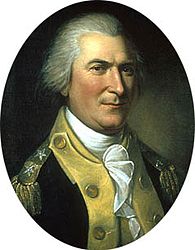File:Arthur St. Clair.jpg
Arthur_St._Clair.jpg (469 × 535 pixels, file size: 130 KB, MIME type: image/jpeg)
Captions
Captions
Summary
[edit]| Charles Willson Peale: Portrait of Arthur St. Clair (1737-1818)
|
||||||||||||||||||||||||
|---|---|---|---|---|---|---|---|---|---|---|---|---|---|---|---|---|---|---|---|---|---|---|---|---|
| Artist |
|
|||||||||||||||||||||||
| Title |
Portrait of Arthur St. Clair |
|||||||||||||||||||||||
| Object type |
painting |
|||||||||||||||||||||||
| Genre |
portrait |
|||||||||||||||||||||||
| Depicted people |
Arthur St. Clair |
|||||||||||||||||||||||
| Date |
between 1782 and 1784 date QS:P,+1782-00-00T00:00:00Z/8,P1319,+1782-00-00T00:00:00Z/9,P1326,+1784-00-00T00:00:00Z/9 |
|||||||||||||||||||||||
| Medium |
oil on canvas |
|||||||||||||||||||||||
| Dimensions |
height: 221.2 in (561.9 cm) dimensions QS:P2048,+221.25U218593 dimensions QS:P2049,+191.125U218593 |
|||||||||||||||||||||||
| Collection |
institution QS:P195,Q1190282 |
|||||||||||||||||||||||
| Notes | Arthur St. Clair was born in Thurso, Caithness County, Scotland, on 23 March 1736 (old style); attended the University of Edinburgh briefly and later studied medicine under Dr. John Hunter in London; purchased a commission as ensign in Britain's 60th Royal American Regiment and served in Canada under Generals Jeffrey Amherst and James Wolfe, 1757-1759; married Phoebe Bayard of Boston, 1760; resigned his British commission, 1762, and purchased an estate in the Ligonier Valley of Pennsylvania, 1764; commanded Fort Ligonier, 1767-1769; was appointed surveyor of the Cumberland District, 1770; was designated by Governor William Penn as agent of colonial government in his region, 1771; was a justice of Westmoreland County court; served as secretary to a congressional committee at the Treaty of Pittsburgh, 1775; was commissioned colonel in the Pennsylvania militia, 1775, and in the Continental Army, 1776, commanded the 2d Pennsylvania Battalion in abortive operations in Canada; was appointed brigadier general, 1776, and served with Washington's forces in the battles of Trenton and Princeton, 1776-1777; was promoted to major general, 1777; was assigned to command of Fort Ticonderoga in June and abandoned it in July to a British investing force; was court-martialed and exonerated of blame for failing to hold the post, 1778; was present at the battle of Yorktown and served briefly with General Nathanael Greene in the South; left military service in 1783; was a Pennsylvania delegate to the Continental Congress, 1785-1787, and president of the Congress in 1787; was governor of the Northwest Territory 1787-1802, and administrator of Indian affairs there; was the senior officer of the United States Army, 4 March 1791-5 March 1792; led an expedition into Indian country and was disastrously defeated on the Wabash River, November 1791; resigned his commission in April 1792 and resumed the territorial governorship; was exonerated in a congressional inquiry from blame for the expedition's failure; was removed, for political reasons, as territorial governor by President Jefferson, 1802; died at his Ligonier Valley home on 31 August 1818. | |||||||||||||||||||||||
| Source/Photographer | Independence National Historical Park Collection in Philadelphia, PA | |||||||||||||||||||||||
The Artist
[edit]Charles Willson Peale (1741-1827) gained his initial experience in portraiture by using members of his family as subjects. As his talents expanded, he visited and developed patronage in New England, Maryland, and Virginia, as well as in London, England, finally settling in Philadelphia on the eve of active military service and the creation of his officer portrait gallery. By the close of the century he had painted many of the distinguished figures of the young nation, among them Maj. Gen. Arthur St. Clair who was completing his first military service in the Revolutionary War. The portrait is reproduced from the Independence National Historical Park Collection in Philadelphia.
Licensing
[edit]| Public domainPublic domainfalsefalse |
| This image is in the public domain because it contains materials that originally came from the United States Army Center of Military History, subject to the following qualification.
Note: The images of all badges, insignia, decorations and medals on the "CMH Online" web site are produced by the United States Army Institute of Heraldry and protected by Title 18, United States Code, Section 704 and the Code of Federal Regulations (32 CFR, Part 507). Permission to use these images for commercial purposes must be obtained from The Institute of Heraldry prior to their use. |

|
– US Army Center for Military History
File history
Click on a date/time to view the file as it appeared at that time.
| Date/Time | Thumbnail | Dimensions | User | Comment | |
|---|---|---|---|---|---|
| current | 08:03, 26 November 2006 |  | 469 × 535 (130 KB) | CORNELIUSSEON (talk | contribs) | {{Information |Description=Arthur St. Clair By Oil on canvas, 221/4" x 191/8", |Source=Independence National Historical Park Collection in Philadelphia, PA |Date=ca. 1782 |Author=Charles Willson Peale |Permission={{PD-USGov-Military-Army-USACMH}} – |
You cannot overwrite this file.
File usage on Commons
The following page uses this file:
Metadata
This file contains additional information such as Exif metadata which may have been added by the digital camera, scanner, or software program used to create or digitize it. If the file has been modified from its original state, some details such as the timestamp may not fully reflect those of the original file. The timestamp is only as accurate as the clock in the camera, and it may be completely wrong.
| Orientation | Normal |
|---|---|
| Horizontal resolution | 75 dpi |
| Vertical resolution | 75 dpi |
| Software used | Adobe Photoshop 7.0 |
| File change date and time | 11:02, 26 January 2006 |
| Color space | Uncalibrated |



